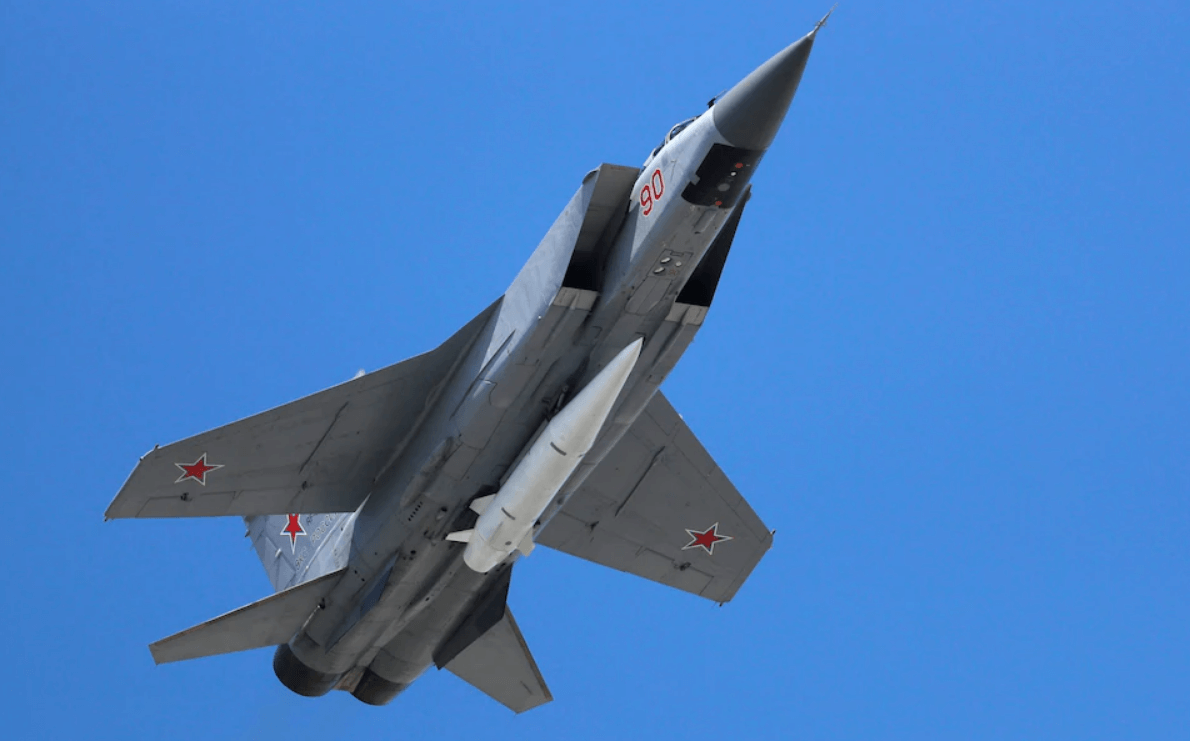During its daily update on the Ukraine war on Tuesday, the United Kingdom (UK) Ministry of Defence Intelligence claimed that Russia has deployed Kinzhal hypersonic ballistic missiles to Belarus’ Machulishchi Airfield.
The ministry shared an image of two Russian MiG-31K fighter jets carrying a large canister that is believed to be storing the Kinzhal missiles, also known as AS-24 Killjoy, from 18 October. “Russia has occasionally launched these weapons during the Ukraine war, but stocks are likely very limited,” it said, adding that basing those missiles in Belarus “gives Russia little added advantage in terms of striking additional targets within Ukraine.”
(5/6)
— Ministry of Defence 🇬🇧 (@DefenceHQ) November 1, 2022
With a range of over 2000km, basing KILLJOY in Belarus gives Russia little added advantage in terms of striking additional targets within Ukraine.
MiG-31K fighter jets were specially developed to carry the missiles, which can reach speeds of Mach 10 – ten times the speed of sound – and have a range of nearly 2,000 kilometres (kms). According to Nuclear Threat Initiative, the missiles were designed to carry 500 kilograms worth of explosives to destroy “high-value targets” like missile defence installations and carrier groups.
In fact, in 2018, Russian President Vladimir Putin boasted about the Kinzhal missiles’ ability to “manoeuvre at all phases of its flight trajectory, which also allows it to overcome all existing and, I think, prospective anti-aircraft and anti-missile defence systems, delivering nuclear and conventional warheads in a range of over [1,243 miles].”
The British Ministry of Defence mentioned that Russia has deployed the hypersonic ballistic missiles since 2018, but never in Belarus. “It has likely carried out the deployment mainly to message to the West and to portray Belarus as increasingly complicit in the war,” the ministry asserted.
Note: The KILLJOY missiles might not even be effective. Russia has already deployed some in Ukraine to limited effect, according to the Pentagon: DOD's Heidi Shyu pointed out "they've shot their KILLJOY hypersonics weapon against a dam. The dam is still there."
— Shannon Vavra (@shanvav) November 1, 2022
Belarus is a steadfast Russian ally and conducted joint military drills in the country called “Allied Resolve” in February before the Ukraine war in order to prepare Russian and Belarusian troops to suppress and repel “external aggression” in combat situations and deal with military “aggravation” at its western and southern borders. Lukashenko said the drills would be perfect to “confront Western powers” like Poland and Ukraine.
Towards the end of February, it renounced its non-nuclear status, paving the way for Russia to deploy nuclear weapons in Belarus for the first time since it gave them up following the collapse of the Soviet Union in 1991. It also permitted Russian troops to remain on its territory indefinitely.
Despite allowing Russian troops to orchestrate attacks on Ukraine from its territory, it has denied being directly involved in the Russian invasion. Furthermore, last month, Belarusian President Alexander Lukashenko announced a joint military force with Russia amid alleged fears that Ukraine, Poland, and Lithuania were training Belarusian radicals “to carry out sabotage, terrorist attacks and to organise a military mutiny in the country.”
“Without escalating the situation, I want you to understand: If you want peace, you need to prepare for war. Always,” he told Belarusian state media Belta.
#Lukashenko has decided today to create combat training centers of #Russia & #Belarus. This will become a cover for the displacement of Russian troops in #Belarus &,in the future,for the creation of a unified 🇷🇺 & 🇧🇾 army under the command of Kremlin. @USAmbBelarus @DirkSchuebel pic.twitter.com/wMCcFdG3nB
— Pavel Latushka (@PavelLatushka) October 31, 2022
He said it was a “purely defensive” alliance, with just 10,000 to 15,000 Russian troops. However, Ukrainian President Volodymyr Zelensky accused Russia of “trying to directly draw Belarus into this war” during an urgent Group of Seven (G7) meeting last month.
Meanwhile, on Tuesday, Belarusian Chief of the International Military Cooperation Department of its Defence Ministry Valery Revenko revealed that Lukashenko had signed a draft agreement approving the “creation and functioning of joint training centers” with Russia, with one in Belarus and another in Russia.

